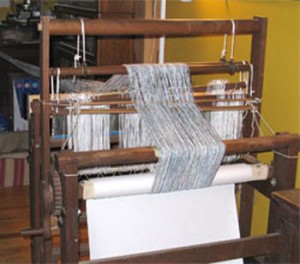
My little loom
It does have its limitations, however, as it’s a counterbalance loom. That means that the harnesses really have to be in balance. On my 4-harness loom, that means 2 harnesses up and 2 harnesses down. Pick 2, any 2. But it can’t do unbalanced weaves – those that require 1 harness up and three down (or vice versa).
Therefore, once I figured out how to understand the directions for doing doubleweave, I had to figure out how to do it on my loom. Doubleweave requires 1 harness to be raised at a time, and that’s not in the nature of counterbalance looms.
Now, I know that there are some companies that make counterbalance looms that can be fitted with a shed regulator – a device that makes it possible to get get a clean shed on an unbalanced weave. So I went online and looked at them, trying to figure out what they did and if one would work on my handmade loom. The best I could determine was that it’d require modifications to the loom that I didn’t know how to make, nor was I sure I wanted them made. (Plus they were fairly costly.)
That was the bad news. The good news was that it appeared to me that the primary thing the shed regulator did was to raise up the entire harness. Could I figure out how to do that on my loom?
Well, since I’d already changed all the cords critical to the loom’s operation to Texsolv, it was a simple matter to shorten the top cords and give it a try. It works! YAY!
Now, it’s true that I don’t get a big shed, so when I’m doing doubleweave I have to work slowly, and I have to advance the warp frequently, but it works!
(For you non-weavers, I’m going to put together a post with weaving terminology, and will explain them with photos.)
I’m not suggesting that this would work on every counterbalance loom, but it works on mine. I wouldn’t do unbalanced weaves all the time, but for the baby blankets, it’s ok. It reinforced once again the lovely, little poem that one of the loom’s prior owners taped to it’s main balance.
My simple pleasures,
my gentle joys
weave a lovely pattern
of contentment in my life.


I have a new Julia, 4 shaft counterbalance loom, it has horses and three shafts can stay up while one goes down, but I have not mastered double weave yet. I have been using elastic to support the top of the harnesses
I don’t have any experience with horses, just roller bars. Hope you continue to enjoy your loom and explore new weave structures!
I am thinking of making a loom for weaving Shaker tape for chair seating. I have Susan Weaver’s book, Handwoven Tape, which includes photographs of small floor looms with two rigid heddles suspended by their centres from a small overhead roller and raised/lowered by two treadles hinged from the front legs. I am looking at fitting four shafts (with Texsolv heddles) with the top roller suspended by Texsolv cords at each end from a crossbeam between the uprights. These cords could be adjusted to achieve a shed with unbalanced lifts. Janet Phillips describes in her book, Designing Woven Fabrics, how she wove a Multi-sectioned Sample Blanket with ten threading plans in the warp and fifty different lift plans in the weft. In the appendix, page 165, she explains how she wove the blanket on a four shaft counterbalance loom. She used a universal tie up to achieve all 14 possible lift sequences on a four shaft loom. Treadle 1 shafts 2 & 4, T2 S4, T3 S3, T4 S2, T5 S1, T6 S1 & 3. She made some adjustments to achieve a shed on the unbalanced lifts and found a ski shuttle useful in a not quite perfect shed. I am planning my loom to have a weaving width of only 10 inches for tape but might widen this to 18 inches to get inside the loom for threading if the front beam is removable. This would be too narrow for lamms so I would fit guides to take the treadle cords from verticaaly above their treadle hole to vertically underneath the centre of its lower heddle bar. Peggy Ostercamp in her book, Warping your loom and Tying on New Warps page 69, says she never changes her all purpose tie-up on her four shaft counterbalance loom using only 4 treadles. T1 S1, T2 S3, T3 S4, T4 S2. For Plain weave treadles 1 & 2 (S1 & 3) are treadled together with the left foot and T3 & 4 (S4 & 2) with the right foot.
2/2 Twill left foot right foot
1 2 treadles
3 2
3 4
1 4
This walks the treadles.
A counterbalance floor loom is light to treadle and fast. It would be easy for a child to use compared with a table loom if there was a raised point of attachment for the treadles. It would be easy to widen the loom in the future and fit six treadles and lamms.
I am trying to make my shaft equal value of space so my weave is more balance trying to find some info on my old nileus counter balance
I sometimes had to play with my strings so that my shafts were even. And I raised all the shafts to do doubleweave on my counterbalance. Be patient – with your loom and yourself – and you will have success. 🙂